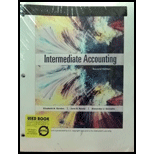
Intermediate Accounting, Student Value Edition (2nd Edition)
2nd Edition
ISBN: 9780134732145
Author: Elizabeth A. Gordon, Jana S. Raedy, Alexander J. Sannella
Publisher: PEARSON
expand_more
expand_more
format_list_bulleted
Textbook Question
Chapter 1, Problem 1.7E
Rules-versus Principles-Based Accounting. Review the following statements and indicate if the statement is referring to a principles-based or a rules-based accounting standard.
| Statement. An accountant will use a particular accounting standard only if ... | Principles-Based or Rules-Based Accounting Standard |
| a. ... the length of a contract covers substantially all of the useful life of a plant asset. | a. ____________________ |
| b. ... the number of new common shares a firm issues is equal to 20% of the previously outstanding shares. | b. ____________________ |
| c. ... a corporation owns over 50% of the voting shares of an affiliate company. | c. ____________________ |
| d ... a corporation has the ability to control the operating and financing activities of an affiliate company. | d. ____________________ |
| e. ... it is more likely than not that a company’s tax position will be sustained upon examination by the Internal Revenue Service. | e. ____________________ |
| f. . .. the sum of the undiscounted future |
f. ____________________ |
Expert Solution & Answer
Want to see the full answer?
Check out a sample textbook solution
Students have asked these similar questions
Can you explain the correct approach to solve this general accounting question?
Can you help me solve this financial accounting question using valid financial accounting techniques?
??!!
Chapter 1 Solutions
Intermediate Accounting, Student Value Edition (2nd Edition)
Ch. 1 - Prob. 1.1QCh. 1 - Prob. 1.2QCh. 1 - How is the allocation of capital linked to the...Ch. 1 - Prob. 1.4QCh. 1 - What is the function of the accounting standard...Ch. 1 - Can U.S. companies listen on U.S. stock exchanges...Ch. 1 - Prob. 1.7QCh. 1 - Prob. 1.8QCh. 1 - Prob. 1.9QCh. 1 - Prob. 1.10Q
Ch. 1 - Prob. 1.1BECh. 1 - Prob. 1.2BECh. 1 - Financial Statement Users and Other Parties...Ch. 1 - Prob. 1.4BECh. 1 - Prob. 1.5BECh. 1 - Economic Entity. What is an economic entity?Ch. 1 - Prob. 1.7BECh. 1 - Prob. 1.8BECh. 1 - Prob. 1.9BECh. 1 - Prob. 1.10BECh. 1 - Prob. 1.11BECh. 1 - Prob. 1.12BECh. 1 - Financial Accounting. Define financial accounting...Ch. 1 - Prob. 1.2ECh. 1 - Convergence of Accounting Standards, IFRS Vikram...Ch. 1 - History of Standard Setting in the United States....Ch. 1 - Prob. 1.5ECh. 1 - Prob. 1.6ECh. 1 - Rules-versus Principles-Based Accounting. Review...
Knowledge Booster
Learn more about
Need a deep-dive on the concept behind this application? Look no further. Learn more about this topic, accounting and related others by exploring similar questions and additional content below.Similar questions
- I need guidance with this financial accounting problem using the right financial principles.arrow_forwardKindly help me with this General accounting questions not use chart gpt please fast given solutionarrow_forwardDuring the fiscal year 2023, Fenix Freight reported net sales of $38,900 million and a net income of $210 million. At the beginning of the year, the company had total assets of $30,400 million, and by the end of the year, total assets had decreased to $29,200 million. What was Fenix Freight's Return on Assets (ROA) for 2023?arrow_forward
- Please explain this financial accounting problem by applying valid financial principles.arrow_forwardI am searching for the correct answer to this financial accounting problem with proper accounting rules.arrow_forwardCan you help me solve this financial accounting question using valid financial accounting techniques?arrow_forward
- Can you solve this general accounting problem using accurate calculation methods?arrow_forwardLockheed Corp. has assets of $342,750 and liabilities of $156,830. Then the firm receives $45,620 from an investor in exchange for new stock, which the firm issues to the investor. What is the value of stockholders' equity after the investment?arrow_forwardI need help finding the accurate solution to this general accounting problem with valid methods.arrow_forward
arrow_back_ios
SEE MORE QUESTIONS
arrow_forward_ios
Recommended textbooks for you
 Intermediate Accounting: Reporting And AnalysisAccountingISBN:9781337788281Author:James M. Wahlen, Jefferson P. Jones, Donald PagachPublisher:Cengage LearningPrinciples of Accounting Volume 1AccountingISBN:9781947172685Author:OpenStaxPublisher:OpenStax College
Intermediate Accounting: Reporting And AnalysisAccountingISBN:9781337788281Author:James M. Wahlen, Jefferson P. Jones, Donald PagachPublisher:Cengage LearningPrinciples of Accounting Volume 1AccountingISBN:9781947172685Author:OpenStaxPublisher:OpenStax College Auditing: A Risk Based-Approach (MindTap Course L...AccountingISBN:9781337619455Author:Karla M Johnstone, Audrey A. Gramling, Larry E. RittenbergPublisher:Cengage Learning
Auditing: A Risk Based-Approach (MindTap Course L...AccountingISBN:9781337619455Author:Karla M Johnstone, Audrey A. Gramling, Larry E. RittenbergPublisher:Cengage Learning

Intermediate Accounting: Reporting And Analysis
Accounting
ISBN:9781337788281
Author:James M. Wahlen, Jefferson P. Jones, Donald Pagach
Publisher:Cengage Learning

Principles of Accounting Volume 1
Accounting
ISBN:9781947172685
Author:OpenStax
Publisher:OpenStax College

Auditing: A Risk Based-Approach (MindTap Course L...
Accounting
ISBN:9781337619455
Author:Karla M Johnstone, Audrey A. Gramling, Larry E. Rittenberg
Publisher:Cengage Learning
IAS 29 Financial Reporting in Hyperinflationary Economies: Summary 2021; Author: Silvia of CPDbox;https://www.youtube.com/watch?v=55luVuTYLY8;License: Standard Youtube License